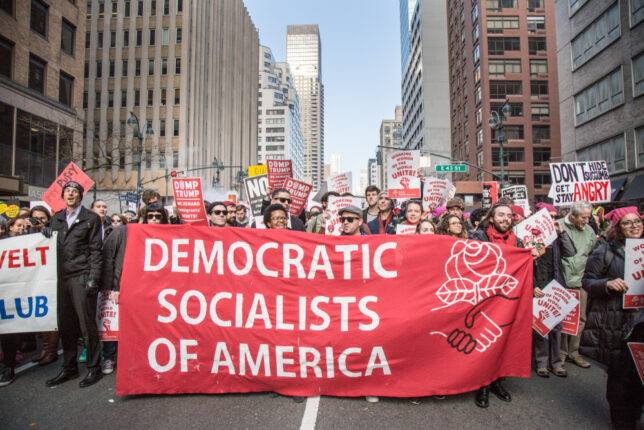Organization Trends
Turmoil at the Democratic Socialists of America
 Democratic Socialists of America (DSA) protesters at the 2017 NYC Women's March. Credit: Kate Way. License: Shutterstock.
Democratic Socialists of America (DSA) protesters at the 2017 NYC Women's March. Credit: Kate Way. License: Shutterstock.

Maria Svart, the longtime national director of the Democratic Socialists of America (DSA), recently tendered her resignation to the organization’s governing National Political Committee. Her announcement caps what has been a tumultuous six months for the socialist activist group and spotlights its precarious financial situation heading into 2024.
A Financial Crisis
Svart’s tenure as national director saw the DSA pass through the most dynamic period in the group’s 40+ year history. When she took over in 2011, it had approximately 5,000 members. A series of major national political events—self-described democratic socialist Bernie Sanders’ unexpectedly vigorous 2016 campaign for president, Donald Trump’s subsequent election later that year, and DSA member Alexandria Ocasio-Cortez’s upset Democratic primary win in 2018—all combined to foster explosive growth at the DSA. Membership peaked at around 95,000 in 2021, before declining to just under 78,000 by mid-2023. This was prior to the DSA’s widely (and rightly) condemned response to the October 7th Hamas terrorist attacks on Israel, which led to some high-profile public resignations.
Indeed, membership appears to be one area where the DSA’s struggles are particularly acute, and this is helping drive a serious fiscal crisis at the largely dues-supported organization. While Svart wrote that hundreds were joining the DSA each month, more were leaving or allowing their memberships to lapse. She noted that the group was undergoing “a period of membership shrinkage and increasing financial stress” and—remarkably—that unless things changed the DSA would soon “be unable to pay all our bills.”
The DSA’s financial woes appear to be largely self-inflicted. Svart faulted delegates at the group’s 2023 national convention for being unable to “fully realize the realities of the budget or debate the real tradeoffs inherent in the resolutions considered.” According to her, paying for everything that the convention delegates voted for would result in roughly a $2 million budgetary deficit—money the DSA doesn’t have. At current trajectories, the activist group is projected to run out of money in a matter of months.
The DSA’s various internal ideological caucuses have also published their perspectives on the crisis and what should be done about it. Some wrote that the DSA’s convention “produced a materially impossible budget mandate” simply because delegates don’t give budgetary realities much thought when voting. Others blamed the National Political Committee for “financial mismanagement . . . while membership dues were known to be declining.” There appears to be something of a consensus that the DSA spent money imprudently, particularly in hiring staff. There is less internal agreement about what exactly should be done about that—with layoffs being the unionized elephant in the room.
In departing, Svart claimed to be “cautiously optimistic” about the DSA’s future and professed a belief that “claims of DSA’s demise are premature.” Nevertheless, she also warned that budgetary realities were soon going to force some “very hard choices” and over the long term necessitate “a reckoning with our structure and our definition of democracy.”
An Outsider’s Observations
As an (admittedly unsympathetic) outsider, it is hard not to make some observations about all of this.
For one, the DSA may simply be reaping the fruits of its radicalization. While this was broadcast to the world in the hours following the October 7th Hamas terrorist attacks, a turn toward a particularly hardcore version of “Everything Leftism” has been underway at the DSA for years. This is best illustrated through the group’s 2021 political platform, the extremist depths of which are rivaled only by its sheer breadth. Maximalist politics do not portend moderation in other areas.
This has also manifested itself in the group’s leadership. At its 2023 national convention, DSA delegates elected at least six revolutionary Marxists and/or communists to the 16-member governing National Political Committee, plus enough more-or-less fellow travelers to make the incoming committee remarkably leftist even by internal DSA standards. Electing leaders who are publicly bent on mass proletarian revolution is not indicative of a membership body that is interested in building a viable American socialist movement à la Bernie Sanders, but rather one in which the most fringe elements have spun themselves into a core that now forms the center of gravity for the entire organization.
At the same time, the DSA’s budgetary problems might simply be inherent to the political proclivities of its membership. This is an organization that wants to “decarbonize the economy” in 10 years via solar, wind, and geothermal energy. It wants to materialize “millions” of government-guaranteed jobs, while providing free “water, energy, transit, food and other necessities” to everyone. It wants the government to pay race-based reparations at the local, state, and federal levels. It wants to unilaterally forgive more than a trillion dollars in student loan and medical debt. It wants a mandatory 32-hour workweek with no corresponding reductions in pay or benefits. And it wants to pay for all of this essentially through military disarmament and “taxing the rich.”
Intrinsic Flaws
In short, perhaps it should not be terribly surprising that DSA members would have difficulty “fully realiz[ing] the realities of [a] budget” or with debating “the real tradeoffs inherent” to the policies they were voting to implement. It is interesting to see some within the DSA recognize this, writing that “we ingrain in ourselves an anti-cuts, abundance mindset.” Truly confronting this mindset, however, would require confronting flaws intrinsic to the very socioeconomic system the DSA was founded to champion. The bottom line is that the socialists have found themselves in deep financial trouble because they spent money that they didn’t have. Frankly, this is a problem that probably just comes with the territory.

